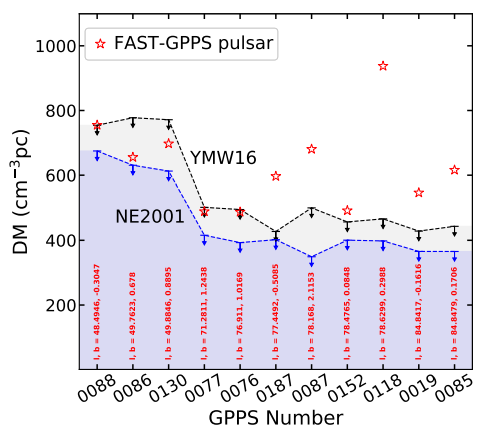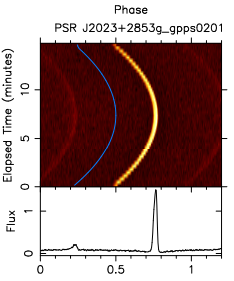Title: The FAST Galactic Plane Pulsar Snapshot survey: I. Project design and pulsar discoveries
Authors: J. L. Han, Chen Wang, P. F. Wang, Tao Wang, D. J. Zhou, Jing-Hai Sun, Yi Yan, Wei-Qi Su, Wei-Cong Jing, Xue Chen, X. Y. Gao, Li-Gang Hou, Jun Xu, K. J. Lee, Na Wang, Peng Jiang, Ren-Xin Xu, Jun Yan, Heng-Qian Gan, Xin Guan, Wen-Jun Huang, Jin-Chen Jiang, Hui Li, Yun-Peng Men, Chun Sun, Bo-Jun Wang, H. G. Wang, Shuang-Qiang Wang, Jin-Tao Xie, Heng Xu, Rui Yao, Xiao-Peng You, D. J. Yu, Jian-Ping Yuan, Rai Yuen, Chun-Feng Zhang, Yan Zhu
First Author’s Institution: National Astronomical Observatories, Chinese Academy of Sciences, Beijing 100101, China
Status: Published in Research in Astronomy and Astrophysics [open access]
Astronomers don’t typically get excited about holes in the ground, but one particular hole has recently garnered quite a lot of attention. Its name is Dawodang, and it’s actually a karst depression half a kilometer wide, formed by limestone and other rocks slowly dissolving. Astronomers are actually less interested in Dawodang’s geological history and more interested in what humans have now built inside it: the largest single-dish radio telescope on Earth.

Located in southwest China, the instrument’s massive size has earned it the nickname Tianyan, or “Heaven’s Eye”, but astronomers know it better as the Five-hundred-meter Aperture Spherical Telescope, or FAST. The dish is shaped like a portion of a sphere and is too large to be steered like smaller telescopes. Instead, FAST uses something called an active surface. An array of 2,225 extremely precise actuators deforms a 300-meter-wide portion of the dish into a parabola, which reflects radio waves to a receiver suspended above the telescope. To track a radio source moving across the sky, astronomers gradually adjust the actuators to shift the parabola accordingly.
Conceived in 1994, FAST achieved first light in 2016 and finished the commissioning process in 2020. Today’s paper talks about one of its first major science findings: The first results of the Galactic Plane Pulsar Snapshot survey (GPPS), which last week reported an astounding 201 new pulsars!

Pulsar surveys have transformed our understanding of these remarkable objects – dense, fast-spinning neutron stars emitting beams of radio waves. As pulsars rotate, this emission creates a periodic signal, with peaks appearing when the beam crosses our line of sight. Pulsar surveys are long-term observing campaigns designed to search some portion of the sky for new sources. For example, the Parkes Multi Beam Pulsar Survey (PMPS) has discovered over 700 pulsars, while the Green Bank North Celestial Cap survey (GBNCC) and the Pulsar Arecibo L-band Feed Array (PALFA) survey have each discovered about 200. These are impressive figures, especially considering that astronomers have only discovered about 3000 pulsars to date.
As one of the most sensitive radio telescopes in the world, it should be of no surprise that FAST has already made contributions of its own. The Galactic Plane Pulsar Snapshot survey utilizes the telescope’s snapshot mode, which can cover roughly 1/6 of a square degree of sky in 21 minutes. It focuses on the disk of the Milky Way, which hosts most of the Galaxy’s stars and stellar remnants, pulsars included! The GPPS survey began in late 2019 and is still ongoing, but the first results are now out – and wow, there is a lot to unpack.
The first set of data includes 201 pulsars, already comparable to the yields of GBNCC and PALFA. Most of these sources hadn’t been detected before because they’re simply too faint, but FAST’s large collecting area, precise active surface, and new L-band receiver allow it to detect pulsars with flux densities an order of magnitude lower than the limits of most existing radio telescopes, as shown in Figure 2. Some of the faint new discoveries are truly intrinsically dim, not just far away, which may open doors for astronomers to learn about pulsars with low radio luminosities.
The next surprise for pulsar astronomers is a group of 11 pulsars with unusually high dispersion measures. A radio source’s dispersion measure, or DM, quantifies the amount of free electrons between the source and the observer; large DMs correspond to sources that are far away or behind dense regions. We have several models of the free electron distribution in the Milky Way, and because the Milky Way is finite in size, there’s a limit to how high a DM can be for a source in any given direction. These 11 pulsars have DMs higher than the maximum values predicted by the two main electron density models, the YMW16 model and the NE2001 model. This probably indicates that there are other structures contributing to the electron density along the lines of sight to these 11 pulsars – probably groups of not-yet-modeled H II regions, clouds of ionized gas often associated with hot young massive stars.

Another 40 new pulsars from the GPPS dataset have spin periods of less than 30 milliseconds, with a subset of those rotating fast enough to qualify as millisecond pulsars, or MSPs. MSPs are interesting in their own right – astronomers think they’re the result of old pulsars accreting matter from a companion, gaining angular momentum and dramatically increasing their rotation speeds – but they’re also extremely handy tools. For example, millisecond pulsars are the components of pulsar timing arrays (PTAs), which aim to detect gravitational waves by looking for shifts in the arrival times of pulses. This is because they’re extremely stable: their pulse periods change only very slowly over time. With dozens of candidates from the first GPPS release alone, it’s possible that some of FAST’s discoveries will find their way into fledgling or still-growing PTAs, like the Indian Pulsar Timing Array or the International Pulsar Timing Array. 14 of the pulsars appear to lie in binary systems, and while this them makes them harder to time, it fits with what we expect from models of millisecond pulsars.

Not all pulsars are as stable as millisecond pulsars, though. Some exhibit phenomena called nulling, where a pulsar seems to turn of its emission for several spin periods, or mode switching, where a pulsar’s pulse profile varies over time. Unsurprisingly, several of the new GPPS pulsars exhibit one or both of these phenomena; in addition, one source, J1905+0849, is even more erratic. It’s what astronomers call a rotating radio transient, or RRAT. RRATs tend to emit single, sporadic pulses, rather than the mostly regular, periodic emission we see from normal pulsars. This makes them extremely difficult to detect and study with normal methods. Astronomers still don’t know for sure what RRATs are, although there are plenty of ideas, such as pulsars undergoing periods of extreme nulling.
It’s understandable if your head is spinning faster than a millisecond pulsar at this point. Although it’s easy to imagine them as cold, dense, dead lumps, neutron stars are actually dynamic and diverse objects, and any large-scale pulsar survey will reveal a menagerie of flavors. The authors of today’s paper estimate that FAST could discover about 1000 pulsars in total – and that 9000 more could be found by other instruments in the years and decades to come. With “Heaven’s Eye” pointed at the heavens, there’s plenty to be excited about.
Astrobite edited by Macy Huston
Featured image credit: Zhu et al. 2018
The FAST Menagerie | astrobites - Astrobites
Read More
No comments:
Post a Comment